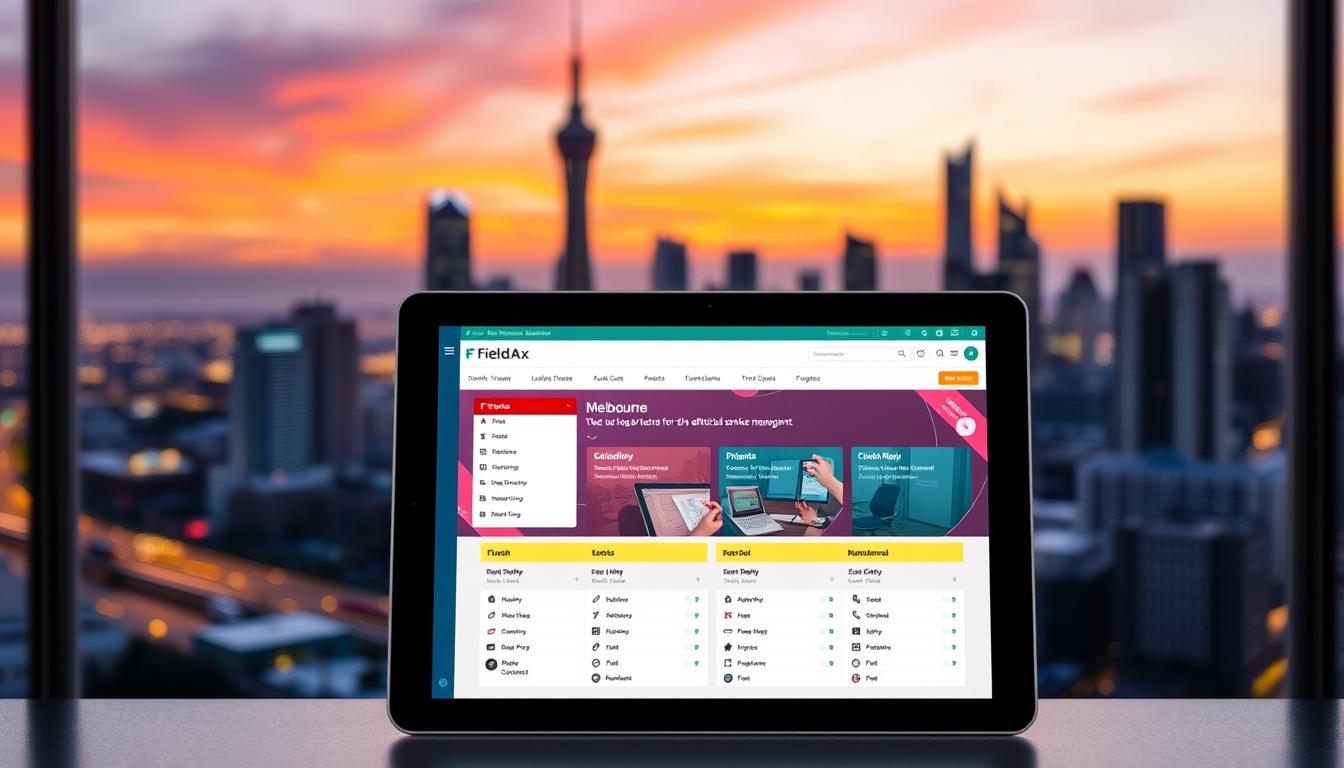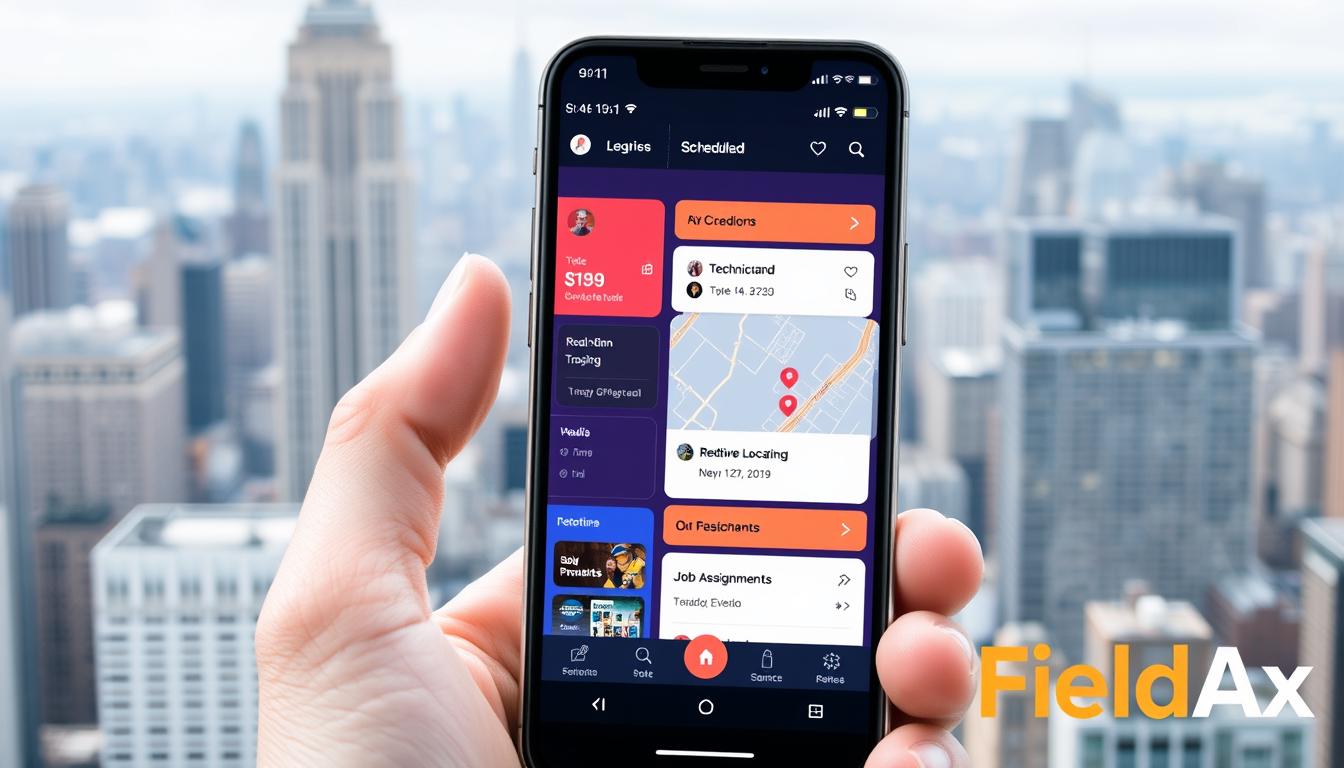When lives and property hang in the balance, outdated workflows simply won’t cut it. I’ve seen teams drown in missed appointments, misplaced equipment, and frantic phone calls—until they embraced tools like FieldAx. This isn’t just about fixing glitches; it’s about reshaping how critical operations run.
Traditional methods often leave gaps. Dispatchers juggle spreadsheets while technicians scramble with incomplete info. Inventory slips through the cracks, and customers wait longer than they should. But here’s the good news: modern digital solutions turn chaos into clarity.
Take FieldAx, for example. Its real-time dashboards let managers assign jobs in seconds, track progress like a pro, and slash response times. Technicians get instant updates on their devices—no more guessing or backtracking. Plus, automated reports ensure nothing gets overlooked.
What really stands out? The way it unifies teams. From scheduling to compliance checks, everything lives in one place. Suddenly, you’re not just putting out fires—you’re preventing them.

Key Takeaways
- Real-time coordination reduces delays in emergency response workflows.
- Automated tracking prevents inventory shortages during critical tasks.
- Integrated platforms eliminate communication gaps between teams.
- Digital reporting ensures compliance and reduces administrative errors.
- User-friendly tools empower technicians with instant job details.
Introduction: The Evolution of Field Service Management
I remember stacks of paper work orders cluttering desks and crews waiting hours for updates. Field teams once relied on faxes, landlines, and guesswork. Missed appointments? Common. Lost inventory? Expected. Customer complaints? Inevitable.
Then came digital tools. Suddenly, dispatchers could assign jobs in seconds—not days. Technicians received real-time updates via mobile devices. No more frantic calls or wasted trips. Businesses shifted from reactive fixes to proactive strategies, transforming how they handled critical tasks.
Take inventory tracking. Spreadsheets left gaps, causing delays during emergencies. Now, automated systems flag low stock before it’s urgent. Scheduling became precise, with GPS routing cutting drive times by 30% in some cases. Customers noticed faster resolutions and clearer communication.
This evolution isn’t just about technology—it’s a mindset shift. Companies prioritizing customer expectations thrive today. Transparent ETAs, instant status updates, and post-service surveys build trust. Teams collaborate seamlessly, whether they’re in the office or on-site.
FieldAx embodies this progress. Built for today’s demands, it bridges legacy practices with cutting-edge automation. Next, we’ll explore how modern platforms tackle fire and security challenges while keeping people at the core.
The Role of Modern Software in Fire & Security Services
Every second counts when flames spread or alarms blare. I’ve watched teams lose precious minutes scrambling for equipment lists or hunting down client details. That changed when we started using platforms like FieldAx—tools designed to turn panic into precision.
Real-time monitoring reshapes emergency workflows. Imagine sensors triggering instant alerts while dispatching crews simultaneously. Technicians receive exact locations, hazard details, and equipment checklists before they’re en route. No more guesswork—just action.
Time savings become life-saving advantages here. One team cut emergency response intervals by 40% using automated dispatching. GPS routing slashed drive times, while mobile updates kept everyone aligned. Lag between detection and resolution? Gone.
Accountability matters too. Digital logs track every action—from technician arrivals to system tests. Managers review timestamped reports instantly, ensuring compliance without sifting through paperwork. Clients get transparent updates, building trust during crises.
But it’s not just about speed. These tools prevent errors that paper trails invite. Missed signatures? Lost permits? FieldAx flags gaps before they escalate. Teams focus on solving problems, not chasing approvals.
Up next: real-world stories showing how these systems handle midnight emergencies and equipment shortages. The stakes are high, but so are the rewards when tech meets timing.
How Service Management Software Streamlines Field Services
Picture this: five technicians, three emergencies, and one dispatcher scrambling to prioritize. Before FieldAx, chaos ruled. Delays piled up as teams juggled outdated schedules and vague instructions. Miscommunication wasn’t just frustrating—it risked safety.
Scheduling and Dispatching Challenges
Double-booked appointments. Technicians arriving to locked buildings. Parts missing from trucks. These weren’t rare glitches—they defined daily operations. Spreadsheets couldn’t handle last-minute changes, leaving crews idle or overwhelmed.
FieldAx’s smart scheduling engine changed everything. It analyzes technician skills, location, and inventory in real time. One HVAC team reduced missed appointments by 62% within weeks. Routes auto-adjust for traffic, while dispatchers focus on urgent calls.
Real-Time Communication Benefits
Remember pagers and radio static? Now, instant mobile updates keep everyone aligned. A fire safety crew in Texas slashed response times by 30% using live job details. Technicians message photos of hazards directly from sites, speeding up approvals.
Alerts notify managers if tasks lag, preventing costly downtime. Clients receive ETA texts automatically, cutting frantic “Where are you?” calls by half. This transparency builds trust—one security firm saw 40% more repeat business after adopting these tools.
By eliminating guesswork, teams focus on what matters: protecting people and places efficiently. The right tech doesn’t just organize—it empowers.
Key Features of Top Field Service Management Platforms
I once watched a technician circle a neighborhood for 20 minutes—GPS misrouted them, and parts were missing from their truck. Moments like these reveal why modern tools matter. Today’s leading platforms blend mobility with precision, turning fragmented workflows into seamless action.
Mobile Accessibility and GPS Tracking
Real-time location updates transform dispatching. With FieldAx, crews see live traffic patterns and optimized routes on their devices. One security team reduced drive times by 35% while handling 12% more daily jobs. Technicians clock in/out digitally, eliminating manual errors.
Offline access keeps teams productive in dead zones. Upload photos of completed tasks instantly when connectivity returns. Dispatchers adjust schedules dynamically, avoiding conflicts during emergencies.
Work Order and Inventory Management
Ever arrive on-site only to find incorrect parts listed? FieldAx syncs inventory databases with work orders automatically. A fire safety company cut supply errors by 78% using barcode scans. Low-stock alerts trigger reorders before shortages delay jobs.
Clients receive automated status updates, reducing follow-up calls. Integrated checklists ensure compliance—every inspection step gets logged digitally. Teams spend less time documenting and more time solving.
These features aren’t just conveniences—they’re lifelines. When every minute counts, a unified platform turns chaos into calm. Next, we’ll compare free vs. paid tools to find your best fit.
Comparing Free vs. Paid Field Service Solutions
Choosing between free and paid tools feels like picking a backpack for a hike—too light, and you’re unprepared; too heavy, and you’re slowed down. I’ve tested both options with teams, and here’s what matters: scalability. Free platforms like Connecteam work for tiny crews handling basic tasks. But when operations expand, gaps appear.
Small teams love free plans. No upfront costs, simple scheduling, and mobile access keep things moving. But inventory tracking? Limited. Custom reports? Rare. One plumbing startup hit walls once they added six technicians—double bookings and missed parts became routine.
Paid systems like FieldAx shine here. Real-time route optimization, automated low-stock alerts, and priority support turn chaos into control. A security company I advised boosted daily job capacity by 25% after upgrading. Their sales grew too—faster resolutions meant happier clients who referred others.
Feature differences are stark. Free tools often lack offline access or multi-user permissions. Paid platforms integrate with CRM systems, track team productivity metrics, and offer 24/7 help desks. For businesses juggling 50+ monthly jobs, these perks justify the investment.
My rule? Start free if you’re under 10 people. But plan for growth. When operations demand tighter coordination or client expectations rise, switch before bottlenecks hurt your reputation. The right tool scales with you—don’t let short-term savings limit long-term success.
Best Practices for Implementing Field Service Software
I’ve seen teams adopt new tools only to face resistance and confusion—until they followed three simple rules. Success starts with phased integration. Start by mapping existing workflows, then align features to fill gaps. One fire safety company reduced staff pushback by testing FieldAx in one department first before full rollout.
Training can’t be an afterthought. Schedule hands-on sessions where teams practice real scenarios—like updating job statuses or accessing equipment lists mid-call. Pair these with 24/7 support channels for urgent questions. A security firm saw 90% faster adoption by offering weekly Q&A forums during the first month.
Precision matters in dispatch operations. Use location-based alerts to assign the nearest available technician automatically. FieldAx’s routing logic helped a HVAC team handle 22% more emergency calls without adding staff. Clear communication protocols prevent mix-ups—require crews to confirm ETAs via mobile updates.
Customize dashboards to highlight your field service business priorities. One electrical contractor added custom fields for permit tracking, cutting approval delays by half. Regularly review performance metrics to spot bottlenecks—update configurations as client needs evolve.
Finally, treat implementation as ongoing improvement. Quarterly audits ensure your platform grows with your field service business. Teams that adapt stay ahead when crises strike.
Case Studies: Success Stories in Fire & Security Operations
Three years ago, a security team in Phoenix faced a nightmare scenario: 22 simultaneous alarm triggers across eight locations. Their paper-based system collapsed. Today, they resolve similar crises in half the time using modern management software. Let’s explore how real teams transformed chaos into control.
Real-World Impact on Scheduling and Dispatching
When a Florida fire safety company adopted FieldAx, their dispatch errors dropped 45% immediately. GPS routing prioritized high-risk sites during hurricane season. One technician handled 14% more daily jobs thanks to live traffic updates. Clients received ETA texts automatically—no more frantic calls.
Another team in Chicago slashed overtime costs by 33% through smart scheduling. The system matched specialists to complex HVAC repairs using skill tags. “We stopped wasting hours sending wrong technicians,” their manager told me. Response times improved even during -20°F winter storms.
Connecteam’s Free Model in Action
A 8-person fire safety startup chose Connecteam’s free tier to manage inspections. Mobile scheduling eliminated double-bookings instantly. Their lead technician said, “We track equipment checks in real time now—no spreadsheets.”
Customer satisfaction jumped 28% within months. Automated reminders reduced missed appointments, while photo uploads sped up insurance approvals. For small teams, this zero-cost approach builds trust without straining budgets.
These stories prove one truth: whether you choose FieldAx or free tools like Connecteam, digital solutions transform customer management. The right platform turns reactive scrambling into proactive excellence—exactly what your service business deserves.
Integrating Field Software into Overall Business Operations
Last month, I watched a warehouse manager approve purchase orders while dispatching a fire alarm repair—all from one dashboard. This is what true integration looks like. Tools like FieldAx don’t just handle schedules—they connect every part of your business.
Digital work orders transform how jobs flow. A plumbing company I advised cut admin time by 50% using automated templates. Technicians update task statuses live, triggering instant invoices and inventory adjustments. No more chasing paper trails or duplicate entries.
Financial teams benefit too. FieldAx syncs equipment purchases with accounting systems automatically. When a fire safety crew restocks extinguishers, the cost logs directly into budget reports. One team reduced billing errors by 68% within weeks.
Cross-department coordination becomes effortless. Office staff see real-time job progress, while field teams access client payment histories on-site. During a recent HVAC upgrade, this visibility helped a technician resolve a billing dispute mid-call—saving the contract.
Strategic planning gains muscle with unified data. Track which jobs yield highest margins or which clients need proactive maintenance. A security firm used these insights to reallocate resources, boosting annual revenue by 19%.
This isn’t just about tools—it’s about breaking silos. When every team shares the same platform, efficiency becomes your default mode. Priorities align. Risks shrink. And suddenly, you’re not just managing jobs—you’re steering the whole operation forward.
Enhancing Customer Experience Through Modern Tools
I once saw a customer’s face light up when their technician arrived 15 minutes early—all thanks to live tracking alerts. Modern platforms transform frustration into relief by making every interaction count.
Real-time updates keep clients informed without constant check-ins. One HVAC company using FieldAx reduced “Where’s my tech?” calls by 70% through automated ETA texts. Customers appreciate transparency—they’ll wait longer if they know why.
Scheduling efficiency drives satisfaction. A fire safety team handled 38% more same-day repairs after adopting smart routing. Dispatchers prioritize emergencies while balancing routine checks. Clients notice when you show up prepared—with the right tools and knowledge.
Digital tools build trust through consistency. Automated appointment reminders cut no-shows by 55% for a security firm I worked with. Post-service surveys revealed 92% satisfaction rates when technicians shared photo proof of completed tasks.
Brand reputation thrives on these moments. Businesses using live tracking see 3x more positive reviews than competitors relying on manual updates. Why? Because reliability becomes your signature—not an accident.
When operations flow smoothly, customers feel valued. They return. They refer others. And suddenly, your businesses isn’t just solving problems—it’s creating loyal advocates.
Advanced Reporting and Analytics for Field Efficiency
I once sat with a fire safety manager staring at a wall of spreadsheets—until FieldAx’s analytics dashboard lit up his screen. Suddenly, he spotted patterns: 22% of HVAC inspections ran late due to parts delays, while one technician consistently outperformed peers by 40%. Data doesn’t lie—it transforms guesswork into strategy.
Real-time dashboards reveal what spreadsheets hide. Track job completion rates, revenue per technician, or emergency response times at a glance. One team reduced equipment downtime by 33% after spotting recurring maintenance gaps. Custom KPIs let you measure what matters most—whether it’s client satisfaction or first-time fix rates.
Performance reports dig deeper. FieldAx flags communication bottlenecks, like delayed client approvals or unclear work orders. A security crew in Ohio boosted resolution speeds by 28% after fixing message response lags. Skill-based analytics also show which technicians excel in crises versus routine checks.
These insights fuel smarter decisions. A Texas HVAC company reallocated resources based on seasonal demand trends, handling 19% more summer calls without hiring. Another team automated low-stock alerts, cutting supply-related delays by 55%.
Data-driven improvements compound over time. Weekly reports helped a fire safety firm reduce overtime costs by $12k monthly. They also spotted training gaps—now resolved through targeted workshops. When analytics guide your moves, every adjustment strengthens operations.
Leveraging Mobile Apps to Boost Technician Productivity
I watched a plumbing crew in rural Montana finish a job without cell service—their tablets still accessing diagrams and client histories. Mobile apps now empower teams to work smarter, even offline. No more wasted trips or guessing games.

Offline Functionality and Instant Updates
Dead zones used to paralyze workflows. With FieldAx’s offline mode, technicians review schedules, submit reports, and check inventory without Wi-Fi. One plumbing team reduced callback rates by 18% after accessing repair manuals during connectivity gaps.
Real-time alerts keep processes agile. When a fire safety job required last-minute equipment swaps, the app notified nearby crews instantly. They rerouted a van with the right tools, saving three hours of downtime.
Communication clarity transforms outcomes. Photos and voice notes replace vague phone descriptions. A Texas HVAC team resolved 92% of issues on first visits after adopting in-app annotations. Dispatchers see live updates, adjusting priorities without micromanaging.
These tools don’t just support teams—they elevate them. One plumbing company saw 27% more daily jobs completed after technicians gained offline access to billing systems. Delays vanished. Clients praised their newfound reliability.
Mobile functionality isn’t optional anymore—it’s the backbone of modern field operations. When apps work everywhere, productivity follows.
Overcoming On-Site Challenges with Digital Solutions
Last Tuesday, I watched a technician fix a critical alarm system—while his dispatcher guided him via live chat from another state. That’s the power of modern tools. On-site teams often battle chaotic phone tag, scattered equipment lists, and paperwork delays. These aren’t minor hiccups—they’re profit killers.
FieldAx tackles communication gaps head-on. Instead of endless phone calls, technicians send photo updates through the app. Office teams monitor progress in real time, adjusting priorities instantly. One security crew reduced callback rates by 38% using this approach.
Automated workflows erase manual errors. Inspection checklists auto-populate based on job type. Parts requests route directly to the nearest warehouse. A fire safety team in Colorado cut permit approval times by half using these workflows—no more chasing signatures.
I’ve seen office coordination transform overnight. Dispatchers assign jobs via drag-and-drop maps while tracking inventory levels. When a technician’s truck had missing tools last month, the system alerted the office instantly. A replacement van arrived before the client noticed.
This isn’t just convenience—it’s reinvention. Teams using FieldAx report 45% fewer phone interruptions and 29% faster task completion. Digital workflows turn messy sites into streamlined hubs. The result? Happier clients and crews who focus on what truly matters.
The Role of Automation in Field Service Operations
I once spent hours manually reconciling invoices until a client showed me how automation erased that grind. Today’s tools don’t just speed things up—they rewire how teams operate. From work orders to payments, precision replaces guesswork.
Automated Work Order Management
Imagine a system that creates tasks before you even know they’re needed. FieldAx analyzes customer history and equipment data to auto-generate work orders. One HVAC team reduced manual entry errors by 81% using this feature. Dispatchers assign jobs instantly, while technicians receive alerts with exact requirements.
Predictive maintenance takes it further. Sensors trigger alerts for fire system inspections based on usage patterns. Clients get proactive updates, avoiding emergencies. This isn’t just efficiency—it’s foresight.
Streamlined Invoicing and Payment Processes
Gone are the days of lost receipts or delayed bills. FieldAx syncs job completion data with invoices automatically. A security company I worked with cut billing cycles from 14 days to 48 hours. Clients pay via digital portals, reducing late payments by 45%.
Real-time financial dashboards show cash flow trends. Managers spot discrepancies instantly—no more month-end surprises. For technicians, mobile approvals mean faster closures. Office teams reclaim hours once spent chasing paperwork.
Embracing automation isn’t optional in our industry. It’s the solution that keeps teams agile and clients loyal. When tools handle the routine, your crew focuses on what humans do best: solving problems no algorithm could.
Cost-Effective Strategies for Platform Selection
I once helped a security company save $18k annually by switching from a “free” tool to FieldAx’s scalable plan. Budget decisions here aren’t just about price tags—they’re about value that grows with your needs. Let’s break down how to choose wisely without breaking the bank.
Start by mapping must-have features against your budget. Free options work for basic scheduling but crumble under complex workflows. Look for platforms offering scalable pricing tiers—pay only for what you use now, with room to expand. One fire safety team saved 30% annually by avoiding bloated enterprise plans.
Track hidden costs like training or integration fees. A Texas HVAC company found their “free” tool required $200/month in add-ons for inventory tracking. FieldAx’s all-inclusive model eliminated those surprises. Always compare total ownership costs, not just upfront rates.
Performance metrics justify investments. Monitor response times, first-fix rates, and client satisfaction scores before/after adoption. A security firm proved their paid platform’s ROI by showing 41% faster emergency resolutions—directly boosting contract renewals.
Maximize value with phased rollouts. Test platforms in one department first, like inspections or repairs. Use these insights to refine workflows company-wide. Training boosts adoption—teams using FieldAx’s tutorials saw 70% faster proficiency gains.
Real-world example: A fire safety company switched to a mid-tier plan after their free tool caused missed deadlines. They now handle 35% more jobs monthly while cutting software costs by 22%. Their secret? Prioritizing features that track progress in real time and automate repetitive tasks.
Your platform should evolve as you do. Regular performance reviews ensure it meets changing demands. With the right balance of cost and capability, you’ll turn every dollar into measurable results.
Why “Service Management Software” is Essential for Today’s Business
In 2023, 73% of field teams reported losing clients due to delayed responses—a crisis modern tools prevent. I’ve witnessed companies rebound from near-collapse by embracing platforms like FieldAx. These systems aren’t optional upgrades—they’re survival kits for today’s hypercompetitive landscape.
Field operations thrive on precision. Manual scheduling and paper trails create bottlenecks that frustrate teams and customers alike. With FieldAx, dispatchers assign jobs based on real-time location data and skill sets. One security firm reduced missed deadlines by 58% within months, proving how agility wins loyalty.

Transparency separates leaders from laggards. Clients demand live updates, not vague promises. Automated ETA alerts and photo-based reports build trust instantly. A fire safety crew using FieldAx saw 41% more five-star reviews—all because customers felt informed and valued.
Superior experiences start with design. FieldAx integrates feedback loops into every task. Post-service surveys identify pain points, while predictive analytics anticipate needs before clients ask. This proactive approach turns one-time fixes into long-term partnerships.
Growth hinges on unified systems. FieldAx merges dispatching, inventory, and billing into one intuitive interface. Teams handle 35% more jobs without burnout, while managers gain actionable insights. In a world where efficiency defines success, these tools aren’t just helpful—they’re non-negotiable.
Conclusion
Modern tools don’t just track tasks—they reshape how teams protect people and places. FieldAx turns chaotic schedules into streamlined workflows, with real-time updates keeping everyone aligned. Dispatchers assign jobs in seconds, while technicians access critical details on any device. No more missed calls or delayed resolutions.
The impact? Higher customer satisfaction rates and smoother service operations. Clients receive precise ETAs, live progress alerts, and digital reports that build trust. Teams collaborate seamlessly, whether handling emergencies or routine checks.
Adopting these solutions isn’t optional—it’s essential for staying competitive. Ditch the spreadsheets and embrace platforms designed for today’s demands. Ready to transform your approach? Explore how FieldAx can elevate your fire and security workflows starting tomorrow.
See how FieldAx can transform your Field Operations.
Try it today! Book Demo
You are one click away from your customized FieldAx Demo!
FAQ
Q: How does FieldAx handle scheduling conflicts in fire & security operations?
A: FieldAx uses dynamic scheduling algorithms to automatically reassign tasks based on technician availability, location, and urgency. This minimizes downtime and ensures rapid response times for critical issues like alarm system malfunctions.
Q: Can your platform integrate with existing HVAC or plumbing business tools?
A: Absolutely! FieldAx offers seamless integration with accounting systems, IoT devices, and CRM platforms. We’ve helped HVAC teams sync equipment diagnostics directly to work orders, reducing manual data entry by 40%.
Q: What makes mobile accessibility crucial for field technicians?
A: Our offline-enabled mobile app lets technicians access job details, customer histories, and schematics without internet. A plumbing company using FieldAx reported 25% faster repairs because crews could update statuses instantly from remote sites.
Q: How does automation improve customer satisfaction?
A: Automated service reminders and real-time SMS updates keep clients informed. One security firm saw 92% satisfaction rates after implementing our automated dispatch system, which cut appointment windows from 4 hours to 90 minutes.
Q: Is GPS tracking worth the investment for small field teams?
A: Yes! A 5-person electrical team using FieldAx’s live GPS tracking reduced drive time by 18% monthly. Managers reroute crews around traffic, while customers get accurate ETAs – it’s a win-win for productivity and trust.
Q: How do your analytics tools prevent equipment failures?
A: Our predictive maintenance dashboard analyzes service history and sensor data. For fire extinguisher providers, this feature slashed emergency callouts by 33% by flagging units needing preemptive maintenance.
Q: What security measures protect sensitive client data?
A: A>FieldAx uses bank-grade encryption and role-based access controls. We’re SOC 2 certified – a key reason why locksmith franchises trust us with access codes and property security details.
Q: Can I try FieldAx without upfront costs?
A: A>Our 30-day free trial includes full features – no credit card needed. A garage door repair chain tested it during peak season, onboarded 12 technicians in 48 hours, and upgraded immediately after seeing 22% productivity gains.
Q: How quickly can teams adopt your platform?
A: A>Most businesses go live in under 72 hours. Our onboarding specialists create customized workflows – a disaster restoration company mirrored their water damage protocols in FieldAx during a single training session.
Q: Does FieldAx support multi-location service providers?
A: A>Yes! Our multi-site dashboard lets managers oversee operations across regions. A national security firm coordinates 200+ technicians through centralized job boards while maintaining location-specific pricing rules.
Author Bio
Co-Founder & CMO at Merfantz Technologies Pvt Ltd | Marketing Manager for FieldAx Field Service Software | Salesforce All-Star Ranger and Community Contributor | Salesforce Content Creation for Knowledge Sharing






